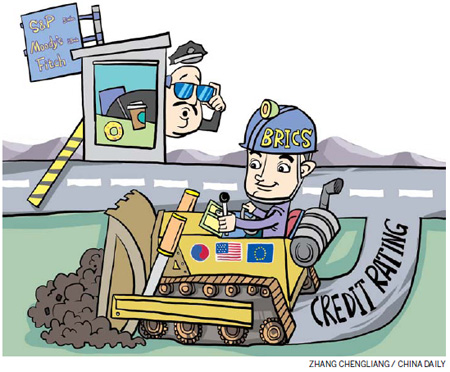
New rating agency would need to be independent and to have credentials from US regulator
Since I penned an article titled "Time for a new credit rating lifeline" (China Daily European Weekly, Aug 19) in which I argued for the formation of a BRICS-led credit rating agency (CRA) to rival Standard & Poor's, Moody's Investor Service and Fitch Ratings, a number of events have taken place within the CRA universe.
It has been reported that the US Justice Department will investigate S&P for its role in improperly rating several mortgage securities in the build-up to the 2008 financial crisis. On Aug 24, Moody's downgraded Japan's government debt by one notch to Aa3. Furthermore, a former Moody's executive informed the US Securities Exchange Commission that the senior management of the company put pressure on its credit analysts to issue favorable ratings in order to please clients and generate further business.
Another event that is likely to have significant ramifications on the structure of the credit rating agencies occurred earlier this month. However, this event was not widely reported in the global financial press. On Sept 6, Dagong Global Credit Rating, the Chinese credit rating agency, indicated that it aims to collaborate with a number of organizations within the BRICS (the emerging economies of Brazil, Russia, India, China and South Africa), the US, Europe and South Korea to form a super-sovereign credit rating agency, which would reduce dependence on S&P, Moody's and Fitch (the "big three").
Guan Jianzhong, the managing director of Dagong, expressed his optimism that the proposed agency "will gain a leading position in the global rating market within the next five years". The formation of a super-sovereign credit rating agency is a step in the right direction, as it would contribute to the improvement of the information asymmetry between debt issuers and investors.
Why is the formation of a new emerging market-led CRA to rival the big three CRAs necessary? What challenges would the proposed agency face and how can they be overcome? What are the prospects for such an agency?
For almost a century, S&P, Moody's and Fitch - which account for 95 percent of the market share - have dominated the global CRA space. Despite the shift in the global financial architecture toward emerging economies, it has been difficult for CRAs from the emerging markets to compete with the big three. One major factor is the lack of access to the world's largest capital market - the US. For a CRA to be recognized as a bond-rater in the US, it is required to obtain a Nationally Recognized Statistical Rating Organization (NRSRO) status, which is granted by the US Securities and Exchange Commission (SEC). So far, only 10 CRAs have been granted the NRSRO designation of which seven are from the US and one each from Canada, France and Japan. There is currently no representative from the emerging market. The formation of a CRA to rival the big three and challenge the dominance of the advanced economies' CRA is long overdue.
Another reason why the formation of this proposed CRA is timely is because of the ongoing reforms and debates impacting the big three CRAs. In the aftermath of the recent downgrades of the US debt and the sovereign debts of a number of European countries, there has been an unprecedented backlash against the big three rating agencies on both sides of the Atlantic. The SEC has recently asked S&P to disclose who within its ranks knew of the decision to downgrade US debt before it was announced. This is an attempt to find out if there was any form of insider dealing.